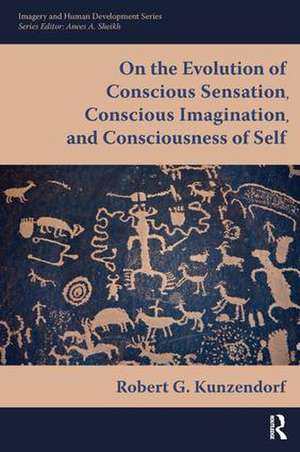On the Evolution of Conscious Sensation, Conscious Imagination, and Consciousness of Self: Imagery and Human Development Series
Autor Robert Kunzendorfen Limba Engleză Paperback – 30 oct 2015
| Toate formatele și edițiile | Preț | Express |
|---|---|---|
| Paperback (1) | 359.53 lei 6-8 săpt. | |
| Taylor & Francis – 30 oct 2015 | 359.53 lei 6-8 săpt. | |
| Hardback (1) | 902.55 lei 6-8 săpt. | |
| Taylor & Francis – 30 oct 2015 | 902.55 lei 6-8 săpt. |
Preț: 359.53 lei
Preț vechi: 436.91 lei
-18% Nou
Puncte Express: 539
Preț estimativ în valută:
68.81€ • 71.57$ • 56.80£
68.81€ • 71.57$ • 56.80£
Carte tipărită la comandă
Livrare economică 15-29 aprilie
Preluare comenzi: 021 569.72.76
Specificații
ISBN-13: 9780895039026
ISBN-10: 0895039028
Pagini: 138
Dimensiuni: 152 x 229 mm
Greutate: 0.2 kg
Ediția:1
Editura: Taylor & Francis
Colecția Routledge
Seria Imagery and Human Development Series
Locul publicării:Oxford, United Kingdom
ISBN-10: 0895039028
Pagini: 138
Dimensiuni: 152 x 229 mm
Greutate: 0.2 kg
Ediția:1
Editura: Taylor & Francis
Colecția Routledge
Seria Imagery and Human Development Series
Locul publicării:Oxford, United Kingdom
Public țintă
Professional Practice & DevelopmentCuprins
PREFACE
In Pursuit of Consciousness
CHAPTER 1
Theoretical Background and the Current Evolutionary Hypotheses
CHAPTER 2
The Evolution of Conscious Sensation
CHAPTER 3
The Evolution of Conscious Imagination
CHAPTER 4
The Evolution of Consciousness of Self
APPENDIX A
Introspective Exercise Demonstrating Binocular Illusion of Fused Sensations
APPENDIX B
On the Role of Pain in Basic Negative Emotions
Endnotes
References
Index
In Pursuit of Consciousness
CHAPTER 1
Theoretical Background and the Current Evolutionary Hypotheses
CHAPTER 2
The Evolution of Conscious Sensation
CHAPTER 3
The Evolution of Conscious Imagination
CHAPTER 4
The Evolution of Consciousness of Self
APPENDIX A
Introspective Exercise Demonstrating Binocular Illusion of Fused Sensations
APPENDIX B
On the Role of Pain in Basic Negative Emotions
Endnotes
References
Index
Recenzii
"On a rare and momentous occasion, an individual will read a discourse so compelling and so powerful as to completely revolutionize the way the individual perceives and thinks about everything. I do not believe it to be a stretch to say that Robert Kunzendorf’s recent monograph, On the Evolution of Conscious Sensation, Conscious Imagination, and Consciousness of Self, has the necessary ingredients to be such a force of metamorphosis.
-Jonathon K. Frost in Imagination, Cognition and Personality: Consciousness in Theory, Research, and Clinical Practice, 2016, Vol. 36(1) 85–88
"This monograph is an excellent exposition of topics from the point of view of a post-Darwinian. Professor Kunzendorf has tackled the evolution of sensation, imagination, and the concept of self within the broader context of consciousness. To my knowledge, this has never been attempted before, and, as such, this book represents an important contribution to the literature of both philosophy and psychology. Anyone interested in the topic of consciousness should read this well-written, scholarly work."
-Benjamin Wallace, professor emeritus of psychology at Cleveland State University, co-author of Consciousness and Behavior
"For anyone intrigued with psychological theories of consciousness, this pioneering new book provides an original evolutionary perspective. Robert Kunzendorf draws on his breadth of scholarship in reviewing and critiquing historic thinkers, from philosophers Descartes and Leibniz through the psychological introspectionists and psychophysicists to recent neuroscientists and cognitive scientists. He then presents a carefully reasoned case for an evolutionary view of consciousness and imagery, positing the mechanisms by which sensation developed into consciousness and then into self-consciousness in large-brained, slow-maturing animals—including humans. A unique, absorbing work."
-Deirdre Leigh Barrett, PhD, author of The Committee of Sleep, teaches at Harvard Medical School
-Jonathon K. Frost in Imagination, Cognition and Personality: Consciousness in Theory, Research, and Clinical Practice, 2016, Vol. 36(1) 85–88
"This monograph is an excellent exposition of topics from the point of view of a post-Darwinian. Professor Kunzendorf has tackled the evolution of sensation, imagination, and the concept of self within the broader context of consciousness. To my knowledge, this has never been attempted before, and, as such, this book represents an important contribution to the literature of both philosophy and psychology. Anyone interested in the topic of consciousness should read this well-written, scholarly work."
-Benjamin Wallace, professor emeritus of psychology at Cleveland State University, co-author of Consciousness and Behavior
"For anyone intrigued with psychological theories of consciousness, this pioneering new book provides an original evolutionary perspective. Robert Kunzendorf draws on his breadth of scholarship in reviewing and critiquing historic thinkers, from philosophers Descartes and Leibniz through the psychological introspectionists and psychophysicists to recent neuroscientists and cognitive scientists. He then presents a carefully reasoned case for an evolutionary view of consciousness and imagery, positing the mechanisms by which sensation developed into consciousness and then into self-consciousness in large-brained, slow-maturing animals—including humans. A unique, absorbing work."
-Deirdre Leigh Barrett, PhD, author of The Committee of Sleep, teaches at Harvard Medical School
Descriere
The post-Darwinian double-aspect theory that Professor Robert Kunzendorf's introduces in On the Evolution of Conscious Sensation, Conscious Imagination, and Consciousness of Self points to evolutionary functions of certain sensations, youngling vivid images, and self-consciousness.






